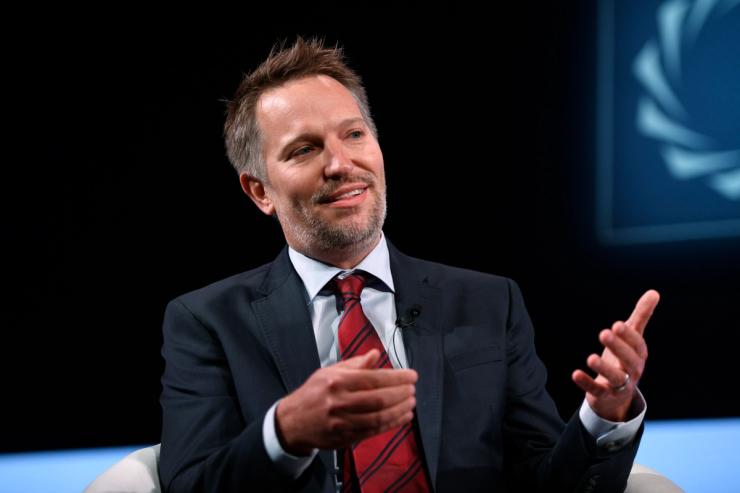The Signal Interview
Ryan Roslansky posted a career update on LinkedIn recently, enthusing in a style familiar to the 1.2 billion people who use the site for professional promotion that he “couldn’t be more excited” about his new role.
The biggest difference from countless other new job announcements on the platform that day was that Roslansky runs the site on which he was posting. Microsoft, which bought LinkedIn for $26.2 billion in 2016 and made him its CEO in 2020, had just expanded his responsibilities, putting him in charge of products like Excel, PowerPoint, and Word, plus the software giant’s AI-powered 365 Copilot productivity tool.
The elevation plays to Roslansky’s reputation as an effective product manager at a time when, as he puts it, “AI is reshaping how people interact with all types of software,” and the venerable components of Microsoft Office “need to be reimagined.”
It was also a recognition of the growth Roslansky has driven at LinkedIn, whose revenues over the past 12 months topped $17 billion, more than double the annual sales he inherited. At Microsoft’s last quarterly earnings announcement in April, the parent company said LinkedIn’s revenue had increased 8% in constant currency terms year-over-year, while premium subscriptions jumped 75% quarter-on-quarter — and the number of people using its AI-powered coaching tools more than doubled in three months.
Finding online growth without online vitriol
There’s a playbook for finding growth at many consumer-facing online properties, Roslansky says, but it is one LinkedIn has chosen to avoid. “You can chase engagement metrics through vitriolic content [or] entertaining content,” he notes, adding that those ideas have often been brought up at LinkedIn by product managers and engineers who have worked at its competitors.
The business could have seen greater engagement had it imposed fewer restrictions on its platform, he says, but it has tried to “keep LinkedIn as LinkedIn” — focused firmly on topics and tools that will help its users advance in their working lives. Critics grouse that they find too much platitudinous, oversharing, or humble-bragging “thought leadership” on LinkedIn. Still, it is seeing record signups — adding seven new members a second — 22 years after it launched.
Roslansky says his strategy has been to keep the bar high for content in the LinkedIn feed, maintaining its users’ trust and helping it stand out from other platforms and networks.
“It’s always really important for us to stay who we are,” he says. “We’re not going to win by being someone else in this game.” The decision by Microsoft CEO Satya Nadella to let LinkedIn operate with a measure of independence within its parent company has also given it the chance to concentrate on long-term value creation rather than chasing short-term metrics for Wall Street, Roslansky adds.
Defending LinkedIn’s place in an AI-driven job market
Roslansky joined LinkedIn as chief product officer in 2009, after working at Glam Media, Yahoo, and an online real estate business he co-founded. His conversations are peppered with details about the new products his team is adding to LinkedIn.
One called AI Role Play lets users quiz a large language model about a new skill rather than taking a course to further their knowledge. Another uses a voice-enabled AI interviewer to prompt early-career users to create their first resume. Then there’s LinkedIn’s AI coaching tool — which might help CEOs practice before they meet journalists, for example, to anticipate the questions they might face. (“I didn’t do it now because I just got out of a meeting,” he says.)
Some have been more successful than others. Many users tried out an AI-powered tool that offers to make their LinkedIn posts look more polished, but it hasn’t caught on, Roslansky says. LinkedIn is “your professional identity,” he says, so its users need to sound authentic. People posting AI-generated content “get called out” on the site, he adds, “and you don’t want to get called out in your professional context.”
AI tools are transforming the labor market, with job seekers using them to submit hundreds of applications at a time to employers, who deploy them to sift through thousands of resumes. It’s a rapid disruption of a marketplace LinkedIn has made its own, but Roslansky rejects the idea that AI will cut LinkedIn out of the equation.
His business runs “the largest talent marketplace in the world,” he says, providing employers with the triaging tools they need, and job applicants on the other side of the equation with new ways to find the jobs that might fit their interests and the skills to qualify for them. The core challenge in social networking is “matching,” he says — pairing up job seekers with hiring managers, content with consumers who will find it relevant, and advertisers with prospective buyers. “All of these are matching problems, which means, fundamentally, they’re all AI problems.”
Finding the core of a product in need of reinvention
Roslansky anchors his interest in the details of product strategy in such broad-sweep observations about what lies at the heart of his business. His approach to his new portfolio at Microsoft has been similar. When he takes on new responsibilities, he says, he tries to “find the soul of what’s going on. What’s the core belief? Why does it matter?” So he describes Office not as a set of decades-old features on laptops but as keys to how the world creates, analyzes, and communicates. “Word can be your true writing partner. Excel can be your thinking partner. PowerPoint can be your storytelling coach,” he says. Office needs to be reimagined as AI transforms digital habits, he says, but he can bring “consumer internet thinking” from LinkedIn to build on the billion-user product’s strong foundations.
“It’s not about disruption for disruption’s sake. It’s about honing what Office is while also leading it into what it’s meant to become,” Roslansky adds. And the leadership task he sees for himself is about “fully committing to a mission and vision about what the future of work needs to be.”
The ‘messy middle’ of the AI labor revolution
The upheavals AI has brought to the workforce define Roslansky’s explanation of how his strategic challenge has changed in the five years since he became LinkedIn’s CEO. People tend to talk about labor revolutions as though a new technology comes along, everyone adopts it, and then productivity explodes, he says.
“What people oftentimes don’t talk about is the messy middle, that part where people are trying to figure out how to adapt to that new technology, when there’s uncertainty and there’s fear and there’s job loss, and roles are being displaced or replaced or remade,” he says. What he sees from LinkedIn’s unmatched vantage point on the world’s workforce is “a very vulnerable group of people,” he adds. “Everyone’s trying to figure out, what will the next five years of my career look like?”
Such anxieties have been particularly acute about entry-level jobs as employers automate more of the work that they once gave to young professionals. Aneesh Raman, LinkedIn’s chief economic opportunity officer, has been among those warning that the bottom rung of the career ladder is breaking first.
Roslansky, the father of a 19-year-old daughter, sounds more sanguine, saying that her AI-native generation has an opportunity to “shape the future” in “a world that’s brimming with change.”
His AI advice, he says, is: “Try every tool. Learn every tool. The skills that are in demand today might be different six months from now. So, embrace that change. Seek out every opportunity you can to learn a new technology, adapt, and set yourself apart.” He is taking his own counsel as he embarks on the next chapter of his career — and staying firmly on brand.
Roslansky has been using Microsoft’s Copilot heavily as he tries to get to grips with his new portfolio. “I’ll hear all these new terms, acronyms, strategies, and people talking about old projects. I don’t want to be embarrassed and ask someone a question about something I should probably know already,” he says. “So I can just go to Copilot and say, ‘Hey, what was this project all about? Or can you explain what that acronym is?’”
It’s an invaluable tool, he enthuses, “to help you sound smart and not have to go and look like you don’t know what you’re doing.”
Notable
- Research published in the National Library of Medicine found that people who scored high on external networking (but not internal networking within their organization) are more likely to use LinkedIn.
- While LinkedIn is popular for professional development, it’s been criticized lately for placing old posts in users’ feeds, making it less timely than other social media platforms that promote breaking news.


